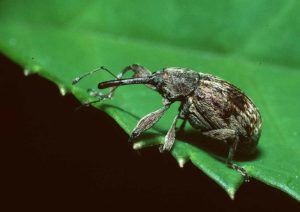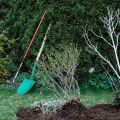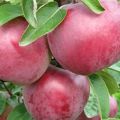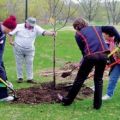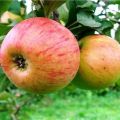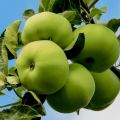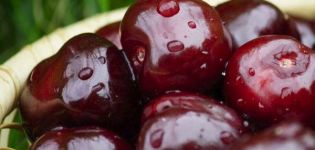How and when is it better to plant an apple tree with a closed and open root system, the distance between seedlings
Spring is the time when every gardener, regardless of experience, thinks about the time to replenish the garden with new seedlings. The most popular trees here are apple trees, they dominate the site. Not all beginners know how to plant an apple tree correctly, what features of a tree are recommended to be taken into account, how to accurately choose a place for planting.
Content
- 1 Features of planting an apple tree
- 2 Selection and preparation of seedlings
- 3 When is it better to plant according to the seasons
- 4 Choosing a landing site
- 5 Preparation of a planting pit on different soils and fertilization
- 6 Preparing a pit for different types and varieties of apple trees
- 7 Planting apple seedlings with a closed root system
- 8 The main stages of the landing
- 9 Features in the regions
- 10 Further care
- 11 Possible mistakes
Features of planting an apple tree
The apple tree is an unpretentious tree that does not require care skills. Despite this, a lot depends on the planting of a seedling - if mistakes are made, there is a great risk of ruining a young plant or waiting for the first fruiting for many years.
Everything should be taken into account when landing:
- the size and age of the seedlings;
- the location of the future adult tree;
- soil features;
- the requirements of the selected variety;
- the timing of planting a young tree.
The chosen planting scheme is considered important - thickened plantings make it difficult to leave, prevent the penetration of sunlight, fresh air.
Selection and preparation of seedlings
Choosing seedlings is easy - the main thing is not to do it in the markets with dubious sellers. The purchase is recommended to be made in proven nurseries, from persons engaged in plant breeding with an impeccable reputation. Ask about the characteristics of the selected variety, requirements for climatic conditions, soil composition, care.
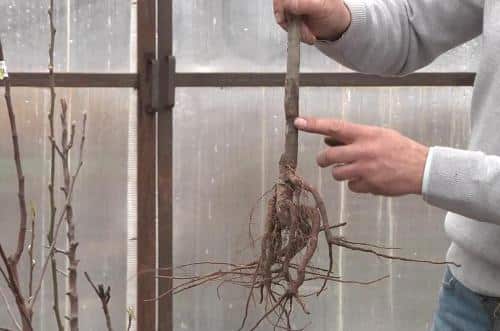
Annuals and biennials differ in survival rate. It is easy to distinguish them - two-year-old seedlings have time to acquire side shoots. They will give a crop earlier than annuals. When purchasing, examine the root system. If a container is hiding it, ask the seller to remove the plant.
A triple rhizome with branches of at least 30 cm and numerous fibrous roots ensure that the seedling takes root without problems.
Carefully examine the cuts on the roots - they must be fresh, without signs of decay. If the tips are dry, there is a possibility that they are slightly frozen or stored improperly, it is better to refuse such a purchase.
When is it better to plant according to the seasons
In addition to choosing a seedling, it is important to find the time for planting - mistakes can become fatal for a tree. Many gardeners with considerable experience believe that it is better to go to the garden in the fall, but there are many opponents of autumn planting - the spring process has no less positive sides. When choosing the time, it is worth paying attention to the climatic conditions, so it is recommended to understand the features of seasonal planting in advance. This will help determine what timing is optimal for a particular region and when it is better to go with the purchased seedling to the garden.
In the spring
If you did not manage to plant the plant in the fall, you should not worry - there is always an opportunity to catch up in the spring. It is imperative to complete the work before May - at this time budding and flowering begin. If you are late, the plant will take root for a long time.
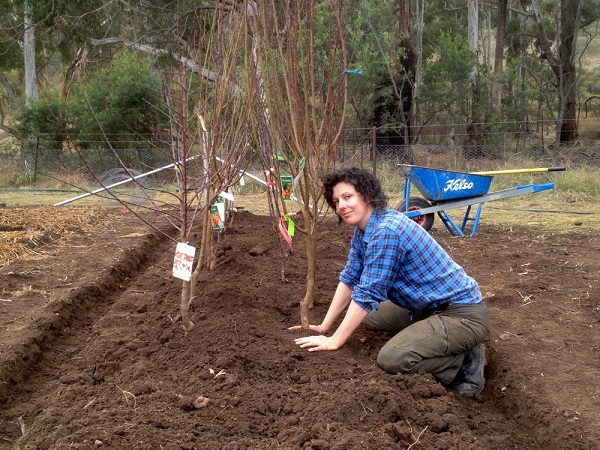
Spring planting benefits:
- there is no risk of freezing of the root system;
- survival rate will pass faster than in autumn - plants have to be planted in the earth warmed up by the sun;
- with the onset of warmth, the plants will start to grow.
There are also many disadvantages here. One of them is that moisture during the winter manages to go to a great depth, you will have to carry out regular watering, otherwise the root system will quickly dry out, which threatens the death of a young tree. Buying spring seedlings will also be much more expensive than autumn plants, and it is difficult to acquire high-quality planting material - it is often sorted out by more efficient gardeners.
Summer
Summer landing is rare. Often, only residents of cool regions are engaged in such work, in which spring begins much later than in warm regions. It is recommended to plant seedlings in a cozy place, which is not penetrated by strong drafts and direct sunlight - survival rate will significantly decrease. It should be borne in mind that you will have to deal with frequent watering - even a slight drying out of the soil is enough to destroy the plants.
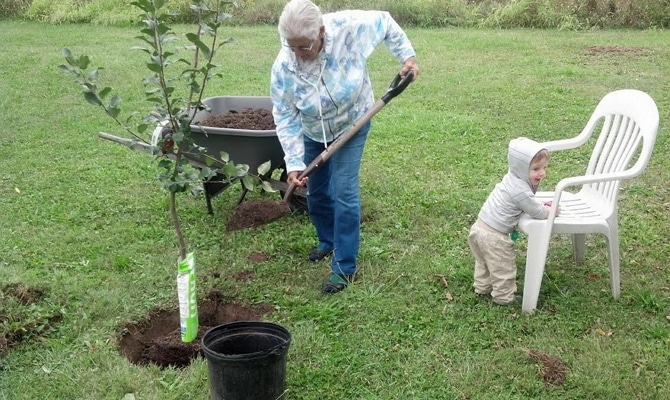
If you just need to transplant a young tree to a new place, it is better to do it in August. There is no particular heat anymore, so the plant will tolerate movement without difficulty. Be sure to transplant with a large lump of soil.
In autumn
The optimal time for planting young trees is October. It usually takes up to 20 days for rooting - this is enough for the root system to settle in a new place before severe stable frosts and to endure the winter without difficulties. It is not difficult to help the plants - put a layer of mulch (sawdust, moss, spruce branches).
The advantages of autumn planting are obvious:
- during the cold season, the root system will have time to get used to it and with the arrival of spring it will quickly start growing;
- mulch over the winter will turn into a layer of nutrients that will penetrate into the ground with melt water;
- with autumn planting, the plant increases its immunity to subsequent frosts - there is no need to worry about freezing.
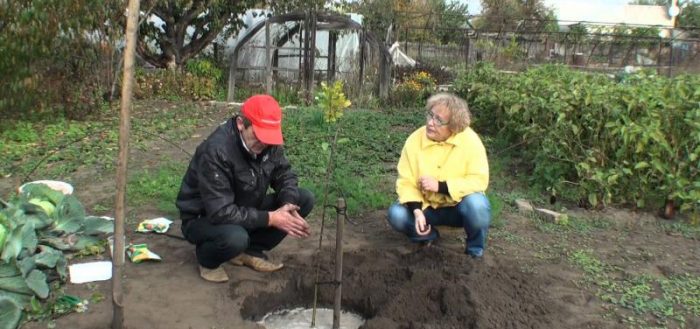
Despite the endurance of young plants, with the arrival of frost, abandon planting - even a cover will not be enough to protect the trees from freezing. Better to postpone planting until spring.
Choosing a landing site
It is important to find a place for apple tree seedlings on the site where it will be comfortable and at ease. It is necessary to take into account the size of an adult plant - over time it should not become cramped. It is not recommended to plant if fruit crops used to grow in this place - pests and harmful bacteria can remain in the soil.
The soil should not be too wet. Water close to the surface can damage the root system and provoke decay.
Preparation of a planting pit on different soils and fertilization
An important rule is to prepare the pits, taking into account all the characteristics of the trees. The simplest and most popular planting scheme is in a row. The optimal distance between the pits is three meters. The distance between the rows is no more than six meters.This is enough for crown formation.
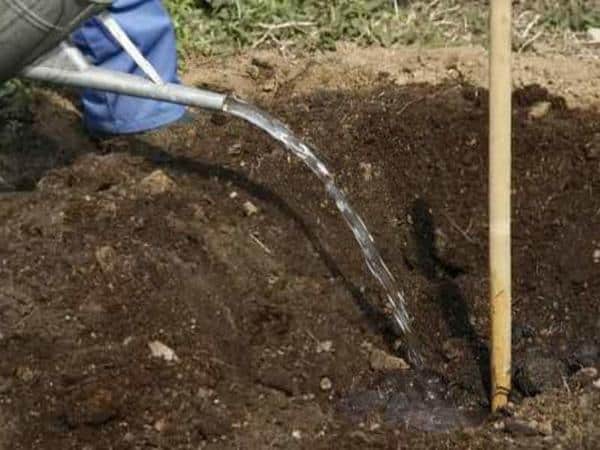
The hole should have a round shape, up to 1 m in diameter. If the root system is too bulky, you can enlarge the hole. The depth for standard varieties is about 65 cm, but it is recommended to deepen the hole if necessary. Usually, fertilizers, nutrients, drainage are placed in the pit - it all depends on the composition of the soil and the requirements of the variety planted.
On clay
Planting on clayey soils has no special requirements. During planting, standard components are added to the pit:
- compost;
- some sand;
- peat;
- garden turf.
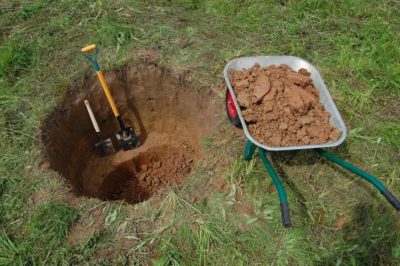
If the groundwater is too close to the surface, the drainage layer should reach 25-30 cm. Use broken bricks, ceramic or clay shards, coarse gravel.
On peat
Peat bogs are nutritious soil that almost does not require the addition of additional elements. Do not forget that too many nutrients for plants are also not recommended, therefore, reduce the nutritional value of the soil. When planting, add coarse river sand, simple garden soil. It is recommended to put a little garden soil in the pit, having previously calcined it in the oven or spilled abundantly with boiling water for disinfection.
On the sand
If planting is carried out in sandy soil, it is recommended to add a clay layer. This is easy to do
- Put drainage in the dug hole.
- Add a small amount of sandstone.
- Put a layer of clay.
- Locate the root system.
- Cover with a mixture of sandstone, peat, compost, garden soil.
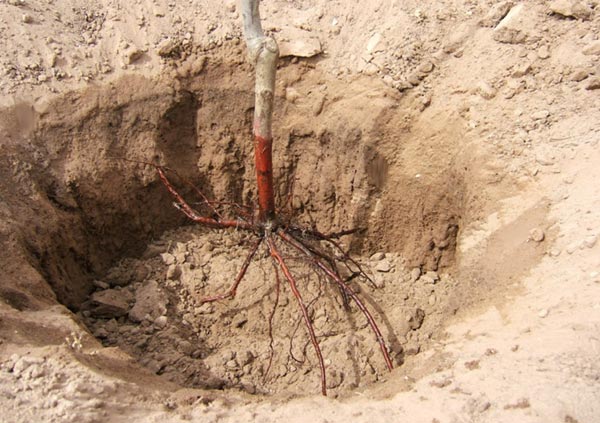
When growing apple trees on sandstones, it should be borne in mind that watering will be the main care process. In sunny weather, such soils get very hot, which is unsafe for plants, so be sure to put a mulch layer.
On loam
When planting an apple tree on loam, it is imperative to lay a drainage layer (ceramic fragments, stones, wood trimmings).
To fill up the root system, use a mixture:
- coarse sand;
- ordinary soil from the garden;
- compost;
- superphosphate (20-50 g)
- peat.
Water clay soils with care, especially after planting - they actively absorb moisture. Even if the surface is dry, water remains at a shallow depth, therefore it is recommended to apply mulch, which allows drying to occur evenly.
Preparing a pit for different types and varieties of apple trees
An important feature of planting apple trees is to take into account crop varieties when preparing holes. Correctly calculate the distance between trees, rows. Each variety of apple trees has its own crown size, which is why it is so important to ask the seller about the characteristics when buying seedlings.
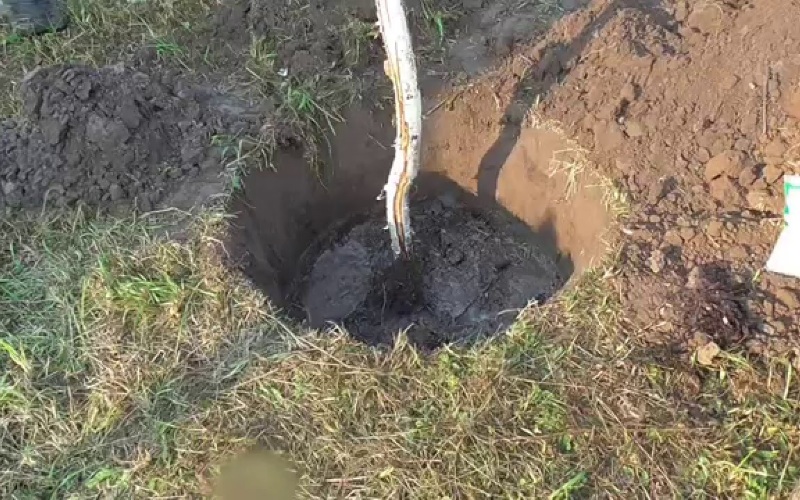
For tall apple trees
The distance between the pits, in which apple trees of high-growing varieties will be planted, is up to 4-5 m. It is recommended to leave a greater distance between the rows - up to 5.5-6 m. The depth of the pit after the laid drainage layer is 80 cm. The diameter is at least one meter. With a large number of small roots and powerful main rhizomes - up to one and a half meters.
For semi-dwarf trees
Medium-sized varieties do not require large pits - one meter is enough in a diameter. The depth after the drain is laid is only half a meter. The distance does not change - between apple trees up to 4 m, between rows - up to 5 m. This is enough for good crown development.
For dwarf trees
Increasingly, dwarf apple trees appear in the gardens, which attract their compact size, yield, ease of care. It is recommended to plant such varieties at a distance of 2-2.5 m. Leave a large distance between the rows - up to 4 m. The depth of the holes is only 40 cm. The diameter is 85 cm. When planting dwarf varieties, be sure to add carbamide (60 g) to the soil. This promotes survival, stimulates the growth of the root system.
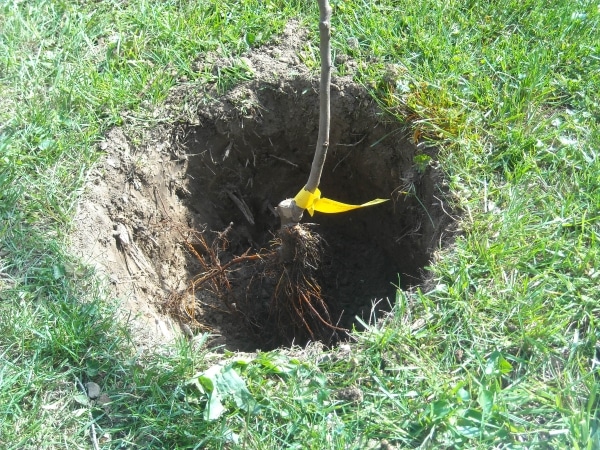
For columnar apple trees
Columnar plants are often planted in small gardens - they do not require a lot of space to grow. The distance between the rows is up to 1.5 m. Place the pits every 55-60 cm. When planting columnar varieties, add organic matter (3 kg), ash (200 g), superphosphate (a handful is enough) into the soil. For too poor soil composition, the addition of mineral elements is recommended.
For apple Melba
Recommended apple tree melba grow on light loam. Silty or clayey soil is not suitable for this variety - it will take a long time to wait for fruiting. The diameter of the hole is standard - within a meter, with a depth of 75 cm. Be sure to add humus, superphosphate when planting. You cannot do without a drainage layer - these varieties do not tolerate soil moisture well.
Planting apple seedlings with a closed root system
The advantage of plants with a closed root system is that they are planted immediately in special containers. This significantly reduces damage during transportation, increases survival rate in a new place, and prevents the development of diseases.

For planting, it is enough to remove the apple tree from the container, trying not to shake off the substrate, and move it to a previously prepared hole. It is recommended to start planting a plant at any time of the year - seedlings will take root perfectly in autumn, summer, early spring.
If near groundwater
An excess of water is dangerous for many fruit crops, and the apple tree is no exception. For the root system, an abundance of moisture is dangerous and often leads to rotting of the root system with the subsequent death of the plant. An artificial mound will help to cope with high humidity and prevent the death of the tree. It is easy to make it - land on a raised bump (about half a meter). With each loosening of the soil, add earth to the mound - you get a gentle, low slope.
At what distance to plant
An incorrectly defined distance between seedlings will certainly lead to thickening of the crowns. A dense planting will provoke the development of diseases, facilitate the movement and work of pests, and make it difficult to collect fruits. The root system, which is fully developing, will also not have enough space, which will affect the development of the apple tree and its fruiting.

The distance, even if the apple trees are located in one row, is not the same for different varieties. The distance should be for large crops - up to 5 meters, for small (columnar, dwarf) varieties - up to a meter.
The main stages of the landing
After preparing the pits, you can start planting. The process is carried out in several stages, each of which should be strictly followed:
- 3-5 hours before planting, lower the root system of the plant into a container with warm water (it is recommended to add 5 g of potassium permanganate per 10 liters of water).
- It is recommended to drive a support into the prepared hole in advance (up to 5 cm in diameter), pre-burn the lower part - this will prevent decay.
- Pour the prepared soil mixture with a low mound into the hole.
- Make a low (up to 5 cm) border in a circle, which will facilitate watering.
- Dip the root system into a prepared chatterbox (mix clay, water, sand), wait a quarter of an hour until the mixture dries.
- Insert an apple tree into the hole, make sure that the root collar rises 3-5 cm above the soil surface.
- Spread the root system, place the roots evenly over the mound.
- Sprinkle the roots with the prepared mixture, tamp with your hands.
- In the process of dusting, gently shake the young tree - this will fill the voids between the roots.
- Water abundantly. Introduce water in small portions, waiting for absorption.
- Put a layer of mulch (chopped straw, sawdust, pine bark).
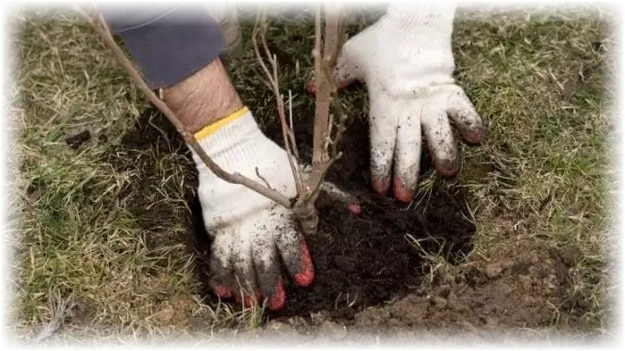
Finish planting by tying up the plant. This will allow you not to worry about the state of the tree in a strong wind - it will not be able to damage the trunk.At a height of 65-80 cm, cut off the main shoot, remove side branches if necessary.
Features in the regions
When planting an apple tree, one should take into account not only the characteristics of the selected variety, but also the climatic features of the regions. This will allow you to grow a healthy tree without hassle, which will begin to bear fruit quickly. When buying, be sure to find out for which latitudes the selected plant is recommended. Thermophilic varieties should not be planted in cold regions - you will not be able to wait for the harvest.
Moscow suburbs
If you are going to grow an apple orchard in the Moscow region, you need to know just a few useful rules:
- planting is best done in the fall (from September to the first cold snaps);
- do not plant young plants in November - there is a risk of ruining the apple trees;
- purchase for growing apple trees with early and medium ripening periods.
If plants are grown that bear fruit late, it will not always be possible to get a harvest - the weather in the Moscow region is unpredictable, and winter may start earlier than usual.
Siberia
The frosty winters for which Siberia is so famous is the main reason for planting young apple trees only in spring. Autumn planting is not recommended - even the most resistant varieties will not be able to survive severe frosts if the root system has not had time to acclimatize.
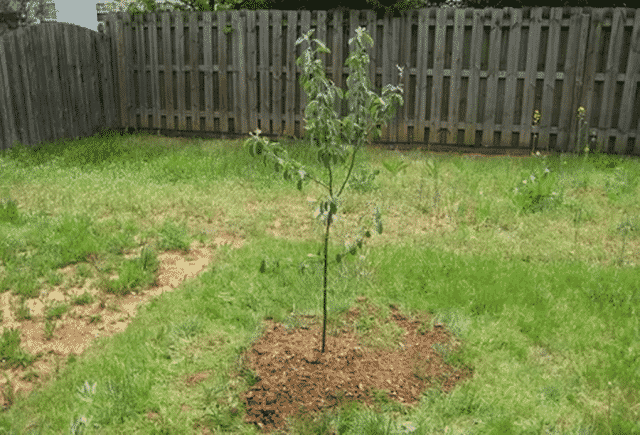
It is better to choose frost-resistant varieties, otherwise you will have to deal with the shelter of plants. Even such a precautionary measure does not always help - until spring, apple trees freeze completely.
Ural
No less dangerous for apple trees is the unpredictable Ural climate, replete with frosty days, which can occur in mid-autumn. It is not recommended to engage in planting until winter - it is better to postpone this process for a stable spring heat. If you had to plant young trees in the fall, be sure to take care of a warm cover. After the snow falls, pour a high snowdrift around the plant - this will partially prevent freezing.
Further care
It will be possible to grow a full-fledged tree with some effort and observing the basic rules of agricultural technology. The first requirement that will have to be fulfilled annually is pruning. In young trees that are actively growing, systematically remove damaged, dry branches. Young shoots, if they appear near the trunk, cut out completely. It is better not to penetrate into the soil and remove growth only on the surface - there is a risk of damaging the root system, which often rises upward.
It is imperative to remove thickened branches - they reduce growth, preventing the penetration of fresh air and sunlight.
First years are recommended to be watered throughout the summer, especially if the warm season does not indulge in rains. It is recommended to pour up to 3 buckets of water on one seedling. Preheat the liquid in the sun for a day. Cold moisture is no less dangerous for young apple trees than hot sun.
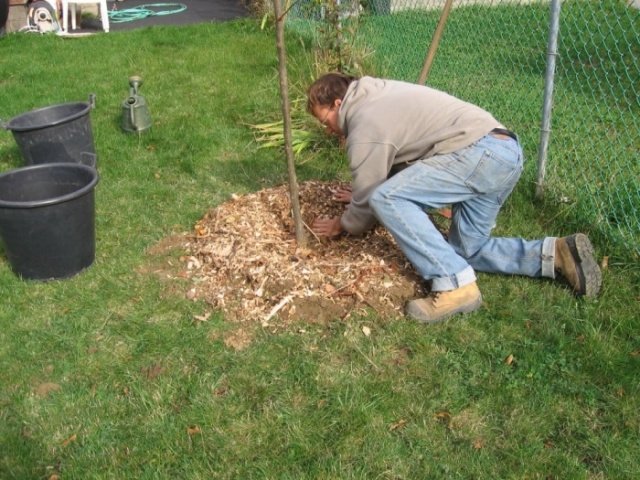
Shallow loosening before each watering. Moisture will penetrate into the fluffed soil much faster, being evenly distributed in the depth of the soil. Remove weeds regularly - weeds actively take up useful elements from the soil, reducing the growth rate of apple trees.
During the first year, it is recommended to carry out about five dressings. Use complex or mineral fertilizers as nutrients.
Pre-abundant irrigation of the soil surface. Top dressing is carried out only under the trunk - fertilization on the leaves will not bring the desired results.
If flowers appear in the first year, you do not need to leave them - there will be no fruit. The barren flowers only take away the strength of the apple trees, so it is better to go to the garden when the buds appear and remove them completely.
Possible mistakes
Most gardeners, even experienced ones, make mistakes when planting apple trees. The main defect, often made by garden owners, is the excess of the seedling deepening.If the root collar is below the surface of the soil, the tree will develop and grow extremely slowly. The norm that is allowed is the rise of the root collar by 3-6 cm above the soil. Some varieties grow well if the point is on a level with the surface of the soil, but it is better to find out in advance, even when buying a seedling.
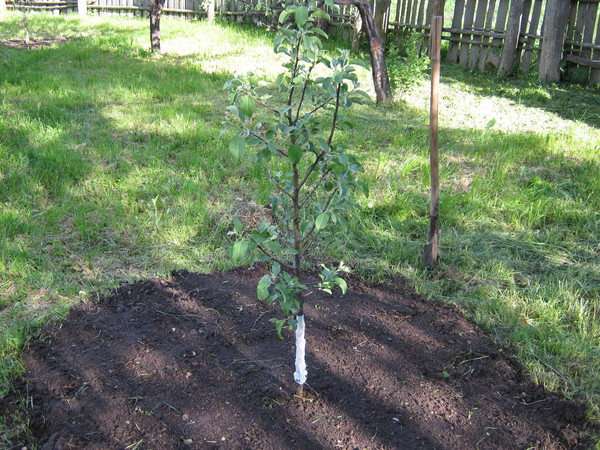
Another major mistake newbies make is using fertilizers too early. Mineral compositions are able to completely destroy the microflora, which contains bacteria useful for the plant. It is recommended to start feeding only after the tree begins to actively develop and release young shoots.
An overabundance of organic matter is also often harmful to young apple trees. Unripe manure, which provokes diseases, is especially dangerous. Ammonia released by fresh organic matter completely displaces oxygen from the voids between the roots, leading to death. In the manure that did not have time to overheat, there may be pests that can destroy plants that did not have time to take root.
Novice gardeners can make a mistake even when buying, acquiring young plants too early. It is quite difficult to keep them at home before planting - a stable cool temperature and high humidity are required.
The only way not to damage the planting material is to send it to the basement with a temperature of about 0 degrees. If this is not possible, it is better to go shopping just before planting - this will prevent unpleasant consequences. When buying, carefully examine the plant raw materials - there should be no rot, mold, dry areas. Too dry roots should also alert - often even soaking is not enough to bring the seedling back to life.
Planting an apple tree is a process that, if carried out correctly, will certainly end with the active growth of the seedling. If you do not make mistakes in care, in just a few years the young tree will delight you with the harvest. Do not forget that the plant requires constant attention - watering, pruning, feeding throughout the year. Gratitude will not keep you waiting - the tree is sensitive to care.
